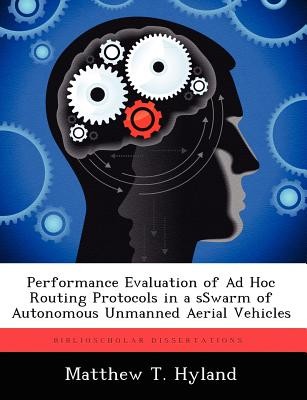
- We will send in 10–14 business days.
- Author: Matthew T Hyland
- Publisher: BiblioScholar
- ISBN-10: 1249592445
- ISBN-13: 9781249592440
- Format: 18.9 x 24.6 x 0.7 cm, softcover
- Language: English
- SAVE -10% with code: EXTRA
Performance Evaluation of Ad Hoc Routing Protocols in a Sswarm of Autonomous Unmanned Aerial Vehicles (e-book) (used book) | bookbook.eu
Reviews
Description
This thesis investigates the performance of three mobile ad hoc routing protocols in the context of a swarm of autonomous unmanned aerial vehicles (UAVs). It is proposed that a wireless network of nodes having an average of 5.1774 log n neighbors, where n is the total number of nodes in the network, has a high probability of having no partitions. By decreasing transmission range while ensuring network connectivity, and implementing multihop routing between nodes, spatial multiplexing is exploited whereby multiple pairs of nodes simultaneously transmit on the same channel. The proposal is evaluated using the Greedy Perimeter Stateless Routing (GPSR), Optimized Link State Routing (OLSR), and Ad hoc On-demand Distance Vector (AODV) routing protocols in the context of a swarm of UAVs using the OPNET network simulation tool. The first-known implementation of GPSR in OPNET is constructed, and routing performance is observed when routing protocol, number of nodes, transmission range, and traffic workload are varied. Performance is evaluated based on proportion of packets successfully delivered, average packet hop count, and average end-to-end delay of packets received.
EXTRA 10 % discount with code: EXTRA
The promotion ends in 20d.03:36:03
The discount code is valid when purchasing from 10 €. Discounts do not stack.
- Author: Matthew T Hyland
- Publisher: BiblioScholar
- ISBN-10: 1249592445
- ISBN-13: 9781249592440
- Format: 18.9 x 24.6 x 0.7 cm, softcover
- Language: English English
This thesis investigates the performance of three mobile ad hoc routing protocols in the context of a swarm of autonomous unmanned aerial vehicles (UAVs). It is proposed that a wireless network of nodes having an average of 5.1774 log n neighbors, where n is the total number of nodes in the network, has a high probability of having no partitions. By decreasing transmission range while ensuring network connectivity, and implementing multihop routing between nodes, spatial multiplexing is exploited whereby multiple pairs of nodes simultaneously transmit on the same channel. The proposal is evaluated using the Greedy Perimeter Stateless Routing (GPSR), Optimized Link State Routing (OLSR), and Ad hoc On-demand Distance Vector (AODV) routing protocols in the context of a swarm of UAVs using the OPNET network simulation tool. The first-known implementation of GPSR in OPNET is constructed, and routing performance is observed when routing protocol, number of nodes, transmission range, and traffic workload are varied. Performance is evaluated based on proportion of packets successfully delivered, average packet hop count, and average end-to-end delay of packets received.


Reviews